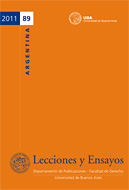Sobre gnomos y gigantes: Los tratados grecorromanos y la igualdad soberana de los estados como ficción histórico-jurídica
Palabras clave:
Igualdad soberana de los Estados, Derecho Internacional, Tratados grecorromanos, Paz de Westfalia, Hegemonía legalizadaResumen
El presente trabajo inicialmente se aboca al estudio de los tratados que componen la Paz de Westfalia y su vínculo real con la construcción de la noción moderna de igualdad soberana de los Estados. A partir de este análisis crítico previo, la lección avanza sobre el estudio de las relaciones interestatales en el mundo griego y el romano, focalizándose principalmente en aquellos convenios celebrados antes de la era cristiana y en la necesidad de estos pueblos de recurrir a dichos instrumentos para fijar reglas de conducta previsibles.
La hipótesis del trabajo, conforme a un vasto análisis de las situaciones propias del mundo antiguo, sugiere que aquellos Estados que se relacionaron en condiciones de desproporción de poder, siempre necesitaron acudir a un velo textual –convencional- de igualdad jurídica para disimular la real desigualdad de poder.
Descargas
Citas
Fuentes primarias (epigráficas y literarias)
Avram, A. (1999a) (ed.) Inscriptions grecques et latines de Scythie Mineure III. Callatis et son territoire, Budapest & Paris.
Blümel, W. (1992) (ed.) Die Inscriften von Knidos I, Bonn.
Browson. C. L. (1918) Xenophon, Vol. 1 (Books 1-4), Cambridge (MA) & London.
-----. (1921) Xenophon, Vol. 2 (Books 5-7), Cambridge (MA) & London.
Butcher, S. H. (1903) (ed.) Demosthenis Orationes, Oxonii.
Büttner-Wobst, T. (1893) (ed.) Polybius. Historiae, Leipzig.
Cagnat, R. et alii (1927) (edd.) Inscriptiones Graecae ad res Romanas pertinentes, IV, Paris (= IGR IV)
Clark, A. C. (1909) (ed.) M. Tulli Ciceronis Orationes, Oxonii.
Corsten, T. (2002) (ed.) Die Inschriften von Kibyra I, Bonn.
Dittenberger, W. (1903-1905) Orientis Graeci Inscriptiones Selectae, I-II, Leipzig (=OGIS).
-----. (1915-1924) (ed.) Sylloge Inscriptionum Graecarum, 3 ed., Leipzig (=SIG).
Foster, B. O. (1919) (ed.) Livy. Books I and II, Cambridge (MA) & London.
Fromentin, V. & J. H. Sautel (1998-) (ed.) Denys d'Halicarnasse. Antiquités romaines, Paris.
Hallof, K. (2000) (ed.) Inscriptiones Graecae consilio et auctoritate, Vol. XII, Fasc. VI, «Inscriptiones Chii et Sami cum Corassiis Icariaque», Berlin & New York (= IG XII).
Murray, G. (1913) (ed.) Euripidis Fabulae, vol. 3, Oxford.
Oldfather, C. H. (1989) (ed.) Diodorus Siculus, Volumes 4-8, Cambridge (MA) & London.
Perrin, B. (1916) Plutarch. Lives, Cambridge (MA) & London.
Rauchenstein, R. (1874) (ed.) Ausgewählte Reden des Isokrates. Panegyricus und Areopagiticus, Berlin.
Repgen, K. (1998) (ed.) Acta Pacis Westphalicae (Hrsg. von der Nordrhein-Westfälischen Akademie der Wissenschaften in Verbindung mit der Vereinigung zur Erforschung der Neueren Geschichte), Serie III [Abteilung B: Verhandlungsakten. Band 1: Die Friedensverträge mit Frankreich und Schweden. 1: Urkunden. Bearb. von Antje Oschmann], Münster (disponible en <http://www.pax-westphalica.de> [consultado el 07-02-2011]).
Sherk, R.K. (1969) (ed.) Roman Documents from the Greek East, Baltimore 1969 (=RDGE).
van Effenterre, H. & F. Ruzé (1994) (edd.) Nomima. Recueil d'inscriptions politiques et juridiques de l'archaïsme grec, Vol. 1, Rome.
Fuentes secundarias (bibliografía crítica)
Accame, S. (1975) Il dominio romano in Grecia dalla guerra arcaica ad Augusto, New York (edición original: Roma, 1946).
Alonso Troncoso, V. (1989) “Algunas consideraciones sobre la naturaleza y evolución de la Symmakhía en época clásica (I)”, Anejos de Gerión II; 165-179.
-----. (2001) “Para un corpus de los tratados de alianza de la Grecia Clásica”, Dike 4; 219-232.
-----. (2002) “La cláusula de la hegemonía en la Liga Délica (Th. 3,10,4; 11,3)”, Ktèma 27; 57-63.
-----. (2003) “L' institution de l'hégémonie: entre la coutume et le droit écrit”, en Thür, G. & F. J. Fernández Nieto (edd.) Symposion 1999. Vorträge zur griechischen und hellenistischen Rechtsgeschichte (Pazo de Mariñán, La Coruña, 6.-9. September 1999) (Akten der Gesellschaft für Griechische und Hellenistische Rechtsgeschichte, 14); 339-354.
Amit, M. (1973) Great and Small Poleis: A Study in the Relations between the Great Powers and the Small Cities in Ancient Greece (Collection Latomus, 134), Brussels.
Anand, R. P. (1986) "Sovereign Equality of States in International Law", Recueil des Cours de l'Académie de Droit International 197, La Haye; 9-228.
Anghie, A. (2004) Imperialism, Sovereignty and the Making of International Law, Cambridge.
Auliard, C. (2006) La diplomatie romaine. L’autre instrument de la conquête. De la fondation à la fin des guerres samnites (753-290 av. J.-C.), Rennes.
Avram, A. (1996) “Der Vertrag zwischen Rom und Kallatis”, en Funck, B. (ed.) Hellenismus. Beiträge zur Erforschung von Akkulturation und politischer Ordnung in den Staaten des hellenistischen Zeitalters, Tübingen.
-----. (1999b) Der Vertrag zwischen Rom und Kallatis. Ein Beitrag zum römischen Völkerrecht, Amsterdam.
Badian, E. (1958) Foreign Clientelae (264-70 B.C.), Oxford.
Balcer, J. (1978) The Athenian Regulations for Chalkis. Studies in Athenian Imperial Law (Historia Einzelschriften, 33), Wiesbanden.
Baltrusch, E. (1994) Symmachie und Spondai. Untersuchungen zum griechischen Völkerrecht der archaischen und klassischen Zeit (8.-5. Jahrhundert v. Chr.), Berlin & New York.
Bancalari Molina, A. (2004) "Coexistencia o enfrentamiento entre el derecho romano y los derechos locales de las provincias", Revista de Estudios Histórico-Jurídicos 26 (Valparaíso); 25-39.
Bandeira Galindo, G. R. (2005) “Martti Koskenniemi and the Historiographical Turn in International Law”, European Journal of International Law 16 (3); 539-559.
Barker, E. (1927) “Greek Political Thought and Theory”, CAH 6; 505-535.
Baronowski, D. W. (1988) “Roman Treaties with Communities of Citizens”, CQ N.S. 38 (1); 172-178.
-----. (1990) “Sub umbra foederis aequi”, Phoenix 44 (4); 345-369.
Bauman, R. A. (1986) “Rome and the Greeks: Apropos of a Recent Work”, Acta Classica 29; 85-98.
Baviera, G. (1898) Il diritto internazionale dei Romani, Modena.
Bearzot, C. (2004) Federalismo e autonomia nelle Elleniche di Senofonte, Milano.
Beaulac, S. (2000) “The Westphalian Legal Orthodoxy – Myth or Reality?”, Journal of the History of International Law 2 (2); 148-177.
-----. (2004) The Power of Language in the Making of International Law. The Word Sovereignty in Bodin and Vattel and the Myth of Westphalia, Leiden.
Bederman, D. J. (2001) International Law in Antiquity, Cambridge.
Belikov, A. P. (2003) Rim i ellenism. Osnovnye problemy politicheskij, ekonomicheskij i kulturnyj kontaktov (“Roma y el helenismo: problemas básicos de los contactos políticos, económicos y culturales”), Tesis Doctoral (Especialidad en Historia del Mundo Antiguo), Stavropol (en ruso).
Bellini, V. (1962) "Foedus et sponsio dans l'évolution du droit international romain", RHD 40; 509-539.
Bernhardt, R. (1971) Imperium und Eleutheria. Die römische Politik gegenüber den freien Städten des griechischen Ostens, Hamburg.
-----. (1998) Rom und die Städte des hellenistischen Ostens (3.-1. Jahrhundert v.Chr.). Literaturbericht 1965-95, München.
Bickerman, E. J. (1950) “Remarques sur le droit des gens dans la Grèce classique”, RIDA 4; 99-127.
Bonk, P. (1974) Defensiv- und offensivklauseln in griechischen Symmakhieverträgen, Tesis de Doctorado, Rheinischen Friedrich-Wilhelms-Universität, Bonn.
Boutros-Ghali, B. (1960) “Le principe d’égalité des États et les organisations internationales”, Recueil des Cours de l'Académie de Droit International 100, La Haye; 2-73.
Brassloff, S. (1928) Der römische Staat und seine internationalen Beziehungen, Wien & Leipzig.
Bryce, T. (1983) The Lycians, Vol. 1 “The Lycians in Literary and Epigraphical Sources”, Copenhagen.
Buis, E. J. (2009) "Las particularidades del acuerdo romano-licio (P. Schøyen I 25) como fuente de derecho internacional: ¿un nuevo foedus iniquum?", Revista de la Asociación de Derecho Romano de la República Argentina 5; 203-219.
Buono-Core Varas, R. (2003) “Los tratados en el mundo romano”, Revista de Estudios Histórico-Jurídicos (Valparaíso) 25; 23-34.
Burton, G. P. (2000) “The Resolution of Territorial Disputes in the Provinces of the Roman Empire”, Chiron 30; 195-215.
-----. (2003) "Clientela or Amicitia? Modeling Roman International Behavior in the Middle Republic (264-146 B.C.)", Klio 85 (2); 333-69.
Byers, M. & G. Nolte (2003) (edd.) United States Hegemony and the Foundations of International Law, Cambridge.
Calabi, I. (1953) Ricerche sui rapporti tra le poleis, Firenze.
Camilleri, J. & J. Falk (1992) The End of Sovereignty? The Politics of a Shrinking and Fragmenting World, Aldershot.
Canali de Rossi, F. (1997) Le ambascerie del mondo greco a Roma in età repubblicana, Roma.
Capogrossi Colognesi, L. (2009) Storia di Roma tra diritto e potere, Bologna.
Cary, M. (1919) “A Forgotten Treaty Between Rome and Carthage”, Journal of Roman Studies 9; 67.
-----. (1920) “The Early Roman Treaties with Tarentum and Rhodes”, JPh 35; 165-173.
Cassayre, A. (2010) La Justice dans les cités grecques. De la formation des royaumes hellénistiques aux legs d'Attale, Rennes.
Catalano, P. (1965) Linee del sistema sovrannazionale romano, Torino.
Cornell, T. J. (1995) The Beginnings of Rome. Italy and Rome from the Bronze Age to the Punic Wars (c. 1000-264 BC), London & New York.
Craven, M. (2007) "Introduction: International Law and Its Histories", en Craven, M., M. Fitzmaurice & M. Vogiatzi (edd.) Time, History and International Law (Developments in International Law, Vol. 58), Leiden & Boston; 1-25.
Croxton, D. (1999) “The Peace of Westphalia of 1648 and the Origins of Sovereignty”, International History Review 21; 569-852.
Cutler, A. C. (2001), “Critical Reflections on the Westphalian Assumptions of International Law and Organization: A Crisis of Legitimacy”, Review of International Studies 27; 133–150.
Dahlheim, W. (1968) Struktur und Entwicklung des römischen Völkerrechts im dritten und zweiten Jahrhundert v. Chr., München.
de Vattel, E. (1758) Le droit des gens, ou principes de la loi naturelle, appliqués à la conduite et aux affaires des Nations et Souverains, Tome II, Londres.
Detter, I. (1966) “The Problem of Unequal Treaties”, International and Comparative Law Quarterly 15; 1069-1089.
Dickinson, E. D. (1917) “Analogy between natural persons and international persons in the law of nations”, Yale Law Journal 26; pp. 564-591.
-----. (1920) The Equality of States in International Law, Cambridge (MA).
Eckstein, A. M. (2006) Mediterranean Anarchy, Interstate War, and the Rise of Rome, Berkeley, Los Angeles & London.
-----. (2008) Rome Enters the Greek East. From Anarchy to Hierarchy in the Hellenistic Mediterrranean, 230-170 BC, Malden (MA) & Oxford.
Ehrenberg, V. (1969) The Greek State, London.
Eyffinger, A. (1998) “Europe in the Balance: An Appraisal of the Westphalian System”, Netherlands International Law Review 45; 161-187.
Fabry, M. (2010) Recognizing States. International Society and the Establishment of New States since 1776, Oxford.
Fassbender, B. (2002) "Article 2 (1)", en Simma, B. (ed.) The Charter of the United Nations. A Commentary, Volume I, New York; 68-91.
Fernández Baquero, M.-E. (1998) “Regulaciones pacíficas en la Roma monárquica”, en Muñoz Muñoz, F. A. & B. Molina Rueda (coord.) Cosmovisiones de paz en el Mediterráneo antiguo y medieval, Granada; 153-190.
Fernández Nieto, F. J. (1975) Los acuerdos bélicos en la antigua Grecia (época arcaica y clásica), Vol. I, Santiago de Compostela.
Ferrary, J.-L. (1990) “Traités et domination romaine dans le monde hellénistique”, en Canfora, L., M. Liverani & C. Zaccagnini (edd.) I trattati nel mondo antico. Forma, ideologia, funzione, Roma : « L’Erma » di Bretschneider, pp. 217-235.
-----. (2001) “Rome et la géographie de l’hellénisme: réflexions sur “hellènes” et “panhellènes” dans les inscriptions d’époque romaine”, en Salomies, O. (ed.) The Greek East in the Roman Context (Proceedings of a Colloquium Organised by the Finnish Institute at Athens, May 21 and 22, 1999), Helsinki; 19-35.
Forsythe, G. (2005) A Critical History of Early Rome. From Prehistory to the First Punic War, Berkeley & Los Angeles.
Franck, T. M. (2002) Recourse to Force. State Action Against Threats and Armed Attacks, Cambridge.
Freytag, K. (2001) “Some News about Inscriptions from North-Western Greece: Preliminary Remarks and Recent Epigraphical Work in the Museums of Thyrion and Agrinion”, en Isager, J. (ed.) Foundation and Destruction. Nikopolis and Northwestern Greece. The Archaeological Evidence for the City’s Destruction, the Foundation of Nikopolis, and the Synoecism (Monographs of the Danish Institute at Athens, 3), Aarhus.
Frezza, P. (1938-9) “Le forme federative e la struttura dei rapporti internazionali nell'antico diritto romano”, SDHI 4 & 5; 363-428 & 161-201.
Gaudemet, J. (1964) “Maiestas populi Romani”, en Guarino, A. & L. Labruna (edd.) Synteleia Vincenzo Arangio-Ruiz, Vol. 2, Napoli; 699-709.
Gaurier, D. (2005) Histoire du droit international. Auteurs, doctrines et développement de l'Antiquité à l'aube de la période contemporaine, Rennes.
Giovannini, A. (2007) Les relations entre États dans la Grèce antique, du temps d’Homère à l’intervention romaine (ca. 700-200 av. J.-C.) (Historia Einzelschriften, Heft 193), Stuttgart.
Glotz, G. (1915) Le droit des gens dans l’antiquité grecque, Paris.
Graham, A. J. (1964) Colony and Mother City in Ancient Greece, Manchester.
Graves, C. E. (1891) Commentary on Thucydides Book 5, London.
Grelle, F. (1990) “Città e trattati nel sistema romano imperiale”, en Canfora, L., M. Liverani & C. Zaccagnini (edd.) I trattati nel mondo antico. Forma, ideologia, funzione, Roma : « L’Erma » di Bretschneider, pp. 237-256.
Grewe, W. G. (1984) Epochen der Völkerrechtsgeschichte, Baden-Baden.
Gruen, E. S. (1984) The Hellenistic World and the Coming of Rome, Berkeley.
Guerber, É. (2010) Les cités grecques dans l’Empire romain. Les privilèges et les titres des cités de l’Orient hellénophone d’Octave Auguste à Dioclétien, Rennes.
Gundel, H. G. (1963) “Der Begriff Maiestas im politischen Denken der römischen Republik”, Historia 12; 283-320.
Hampl, F. (1938) Die griechischen Staatsverträge des 4. Jahrhunderts v. Christi geb., Leipzig.
Hansen, M. H. (1993) “Introduction: The Polis as a Citizen-State”, en Hansen, M. H. (ed.) The Ancient Greek City State. Symposium on the Occasion of the 250th Anniversary of the Royal Danish Academy of Science and Letters (July 1-4, 1992), Copenhagen; 7-29.
Harris, W. V. (1971) Rome in Etruria and Umbria, Oxford.
Harter-Uibopuu, K. (1998) Das zwischenstaatliche Schiedsverfahren im achäischen Koinon. Zur friedlichen Streitbeiligung nach den epigraphischen Quellen, Köln, Weimar & Wien.
Hatzopoulos, M. D. & L. D. Loukopolou (1987) Two Studies in Ancient Macedonian Topography, Athens.
Heitland, W. E. (1915) A Short History of the Roman Republic, Cambridge.
Heuß, A. (1933) Die völkerrechtlichen Grundlagen der römischen Außenpolitik in republikanischer Zeit, Leipzig.
Hueck, I. (2001) “The Discipline of the History of International Law”, Journal of the History of International Law 3; 194-217.
Hunt, P. (2010) War, Peace, and Alliance in Demosthenes’ Athens, Cambridge.
Ion, T. P. (1911) “The Sanctity of Treaties”, Yale Law Journal 20 (4); 268-291.
Jameson, S. (1980) “The Lycian League: Some Problems in its Administration”, ANRW II.7.2 ; 832-855.
Jones, Ch. (2001) “Memories of the Roman Republic in the Greek East”, en Salomies, O. (ed.) The Greek East in the Roman Context (Proceedings of a Colloquium Organised by the Finnish Institute at Athens, May 21 and 22, 1999), Helsinki: Foundation of the Finnish Institute at Athens, pp. 11-18.
Kallet-Marx, R. (1995) Hegemony to Empire: The Development of the Roman Imperium in the East from 148 to 62 B.C., Berkeley.
Kantor, G. (2007) “Ancestral Laws under the Roman Rule: The Case of Lycia”, Tesis para la confirmación del grado de Doctor en Historia Antigua, Balliol College, Oxford (disponible en [consultado el 02-12-2010]).
Karavites, P. (1982) “Eleuthería and Autonomía in Fifth-Century Interstate Relations”, Revue Internationale des Droits de l’Antiquité 29; 145-162.
Keaveney, A. (1981) “Roman Treaties with Parthia circa 95- circa 64 B. C.”, American Journal of Philology 102 (2); 195-212.
Kolb, R, (2010) Esquisse d'un droit international public des anciennes cultures extra européennes, Paris.
Kooijmans, P. H. (1964) The Doctrine of the Legal Equality of States: An Inquiry into the Foundations of International Law, Leiden.
Koskenniemi, M. (1989) From Apology to Utopia. The Structure of International Legal Argument, Cambridge.
-----. (2002) The Gentle Civilizer of Nations: The Rise and Fall of International Law 1870–1960, Cambridge.
-----. (2004) “Why History of International Law Today?”, Rechtsgeschichte 4; 61-66.
Krisch, N. (2005) "International Law in Times of Hegemony: Unequal Power and the Shaping of the International Legal Order", European Journal of International Law 16; 369-408.
Laghmani, S. (2003) Histoire du droit des gens: du jus gentium impérial au jus publicum europaeum, Paris.
Larsen, J. A. O. (1957) “Lycia and Greek Federal Citizenship”, Symbolae Osloenses 33; 5-26.
Laurent, F. (1850-1) "Histoire du droit des gens et des relations internationales", en Histoire de l'humanité, Paris.
Lesaffer, R. (1997) “The Westphalian Peace Treaties and the Development of the Tradition of Great European Peace Settlements prior to 1648”, Grotiana 18; 71-95.
-----. (2004) “Peace Treaties from Lodi to Westphalia”, en Lesaffer, R. (2004) Peace Treaties and International Law in European History: from the Late Middle Ages to World War One, Cambridge; 9-44.
-----. (2007) “International Law and its History: The Story of an Unrequited Love”, en Craven, M., M. Fitzmaurice & M. Vogiatzi (edd.) Time, History and International Law (Developments in International Law, Vol. 58), Leiden & Boston; 27-41.
Lomas, K. (1996) Roman Italy 338 BC- AD 200. A Sourcebook, New York & London.
Low, P. (2007) Interstate Relations in Classical Greece: Morality and Power, Cambridge.
MacKechnie, P. (1989) Outsiders in the Greek Cities in the Fourth Century BC, London & New York.
Marin, D. (1948) “Il foedus romano con Callatis”, Epigraphica 10; 105-114.
Martin, V. (1940) La vie internationale dans la Grèce des cités (VIe-IVe s. av. J.-C.), Paris.
Masi, A. (1957) “Foedus”, en AA.VV. Novissimo Digesto Italiano, Tomo VII, Torino; 420-421.
Mattingly, H. B. (1983) “Rome’s earliest relations with Byzantium, Heraclea Pontica and Callatis”, en Poulter, A. G. (ed.) Ancient Bulgaria. Papers presented to to the International Symposium on the Ancient History and Archaeology of Bulgaria I, Nottigham, pp. 239-252.
McGregor, M. F. (1987) The Athenians and their Empire, Vancouver.
Méndez Chang, E. (2000) “El ius fetiale como derecho supranacional vigente para Roma y los demás pueblos”, Pandectas (Perú) 4; 1-18, disponible en (consultado el 22-04-2008).
Meyer, E. A. (2004) Legitimacy and Law in the Roman World. Tabulae in Roman Belief and Practice, Cambridge.
Millar, F. (2002) Rome, the Greek World and the East (Volume I: “The Roman Republic and the Augustan Revolution”), Chapel Hill & London.
Mitchell, L. G. (1997) Greeks Bearing Gifts: The Public Use of Private Relationships in the Greek World, 435-323 BC, Cambridge.
Mitchell, S. (2005) “The Treaty between Rome and Lycia”, en Pintaudi, R. (ed.) Papyri graecae Schøyen I (Papyrologica Florentina, 35), Firenze; 163-258.
Mommsen, T. (1864) “Das römische Gastrecht und die römische Clientel”, en Römischen Forschungen, Bd. 1, Berlin, 319-90.
Moretti, L. (1962) “La federazione dei Lici”, en Ricerche sulle leghe greche, Roma ; 171-218.
Morgenthau, H. J. (1948) Politics Among Nations: The Struggle for Power and Peace, New York.
Nicolet, C. (19 The World of the Citizen in Republican Rome, Berkeley & Los Angeles, 1980 (edición original: Paris, 1976).
Nörr, D. (1991) Die Fides im römischen Völkerrecht, Heidelberg.
Nussbaum, A. (1947) A Concise History of the Law of Nations, New York.
Oppenheim, L. (1908) “The Science of International Law”, American Journal of International Law 2 (2); 313-356.
Osiander, A. (2001) “Sovereignty, International Relations, and the Westphalian Myth”, International Organization 55; 251–287.
Ostwald, M. (1982) Autonomia: Its Genesis and Early History, Chico (CA).
Oyarce Yuzzelli, A. (2006) “El derecho internacional en Roma. El ‘ius fetiale’”, Vox Iuris, Año 17, nº 13; 119-132.
Panessa, G. (1999) Philiai. L’amicizia nelle relazioni interstatali del Greci, Pisa.
Paradisi, B. (1951) "L'amitié internationale: les phases critiques de son ancienne histoire", Recueil des cours de l'Académie de droit international de La Haye, Vol. 78 (1951-I); 325-378.
Passerini, A. (1935) “Il testo del foedus di Roma con Callatis”, Athenaeum 13, pp. 57-72.
Pérez Martin, E. (2001) Los extranjeros y el derecho en la antigua Grecia, Madrid.
Phillipson, C. (1911) The International Law and Custom of Ancient Greece and Rome, London.
Pistorius, T. (1985) Hegemoniestreben und Autonomiesicherung in der griechischen Vertragspolitik klassischer und hellenistischer Zeit, Frankfurt am Main, Bern & New York.
Plancherel-Bongard, C. (1998) “Les rapports de subordination entre Rome et les conféderations latine et italique”, Revue d’histoire du droit 66 (3/4); 279-287.
Preiser, W. (1976) Frühe völkerrechtliche Ordnungen der aussereuropäischen Welt, Wiesbaden.
Raaflaub, K. A. (1991) “City-State, Territory, and Empire in Classical Antiquity”, en Molho, A., K. Raaflaub & J. Emlen (edd.) City States in Classical Antiquity and Medieval Italy, Stuttgart; 565-588.
Redslob, R. (1923) Histoire des grands principes du droit des gens depuis l’antiquité jusqu’à la veille de la grande guerre, Paris.
Renaut, M.-H. (2007) Histoire du droit international public, Paris.
Reynolds, J. (1982) Aphrodisias and Rome, London.
Rich, J. W. (2008) “Treaties, Allies and the Roman Conquest of Italy", en de Souza Ph. & J. France (edd.) War and Peace in Ancient and Medieval History, Cambridge & New York; 51-75.
Ruiz Moreno, I. (1946) El derecho internacional antes de la Era Cristiana, Buenos Aires.
Ryder, T. T. B. (1965) Koine Eirene: General Peace and Local Independence in Ancient Greece. Oxford.
Salmon, J. (2002) Dictionnaire du droit international, Bruxelles.
Schmitt, H. H. (1992) Rom und die griechische Welt von der Frühzeit bis 133 v. Chr. Antike Quellen in Übersetzung, München.
Schröder, M. (1999) (ed.) 350 Jahre Westfälischer Friede. Verfassungsgeschichte Staatskirchenrecht, Völkerrechtsgeschichte (Schriften zur europäischen Rechts-und Verfassungsgeschichte, 30), Berlin.
Schuler, Ch. (2007) (ed.) Griechische Epigraphik in Lykien. Eine Zwischenbilanz, Akten des internationalen Kolloquiums München, 24.-26. Februar 2005.
Seager, R. (1969) “The Congress Decree: Some Doubts and a Hypothesis”, Historia 18; 129-141.
Sepúlveda, C. (1995) El derecho de gentes y la organización internacional en los umbrales del siglo XXI, México.
Serrati, J. (2006) “Neptune’s Altars: The Treaties Between Rome and Carthage (509-226 B.C.)”, Classical Quarterly 56; 113-134.
Sherk, R. K. (1969) Roman Documents from the Greek East, Baltimore.
Sherwin-White, A. N. (1984) Roman Foreign Policy in the East, 168 B.C. to A.D. I, London.
Simpson, G. (2004) Great Powers and Outlaw States. Unequal Sovereigns in the International Legal Order, Cambridge.
Stern, J. (1987) “Le traité d’alliance entre Rome et Maronée”, Bulletin de correspondance hellénique 111; 501-509.
Stier, H. E. (1957) Roms Aufstieg zur Weltmacht und die griechische Welt, (Arbeitsgemeinschaft für Forschung des Landes Nordrhein-Westphalen, Abhandlung Heft 11), Köln & Opladen.
Straumann, B. (2008) "The Peace of Westphalia as a Secular Constitution", Constellations 15 (2); 173-188.
Täubler, E. (1913) Imperium Romanum. Studien zur Entwickelungsgeschichte des römischen Reichs, Vol. I "Die Staatsverträge und Vertragsverhältnisse", Leipzig & Berlin.
Tausend, K. (1992) Amphiktionie und Symmachie. Formen zwischenstaatlicher Beziehungen im archaischen Griechenland (Historia Einzelschriften, 73), Stuttgart.
Teschke, B. (2002) “Theorizing the Westphalian System of States: International Relations from Absolutism to Capitalism”, European Journal of International Relations 8 (1); 5-48.
Triantaphyllos, D. (1983) “Symmakhia Romaion kai Maroniton”, Thrakike Epeteris 4, pp. 419-449.
Truyol y Serra, A. (1998) Historia del derecho internacional público, Madrid.
van Wees, H. (2004) Greek Warfare. Myths and Realities, Swansea.
Verzijl, J.H.W. (1968) International law in Historical Perspective, Vol. I, Leiden.
Vicuña, J. & L. Sanz de Almarza (1998) Diccionario de los nombres propios griegos debidamente acentuados en español, Madrid.
Wheeler, E. L. (2002) “Roman Treaties with Parthia: Volkerrecht or Power Politics?”, Bar International Series, Vol. 1084 (1); 287-292.
Winkler, L. (2004) “The Peace Treaties of Westphalia as an Instance of the reception of Roman Law”, en Lesaffer, R. (ed.) Peace Treaties and International Law in European History. From the Late Middle Ages to World War One, Cambridge; 222-237.
Wolfke, K. (1961) Great and Small Powers in International Law from 1814 to 1920, Wroclaw.
Zack, A. (2001) Studien zum Römischen Völkerrecht. Kriegserklärung, Kriegsbeschluss, Beeidung und Ratifikation zwischenstaatlicher Verträge, internationale Freundschaft und Feindschaft während der römischen Republik bis zum Beginn des Prinzipats, Göttingen.
Ziegler, K.-H. (1972) “Das Völkerrecht der römischen Republik ”, ANRW I (2); 68-114.
Descargas
Publicado
Cómo citar
Número
Sección
Licencia

Esta obra está bajo una licencia internacional Creative Commons Atribución-NoComercial 4.0.











